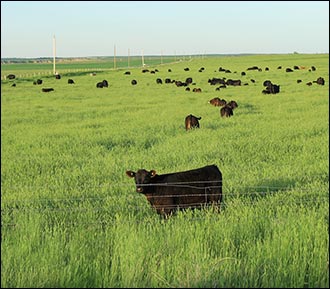Acute Bovine Pulmonary Edema and Emphysema
Range cattle are more susceptible to lung disease going onto lush pastures.

Acute bovine pulmonary edema and emphysema can occur in pastured animals when suddenly changed from dry fall pastures (or a drylot) to lush green pastures.
There are many causes of respiratory disease in cattle, and some are infectious. However, one form of pneumonia that does not appear to be infectious is acute bovine pulmonary edema and emphysema, which can occur in pastured animals when suddenly changed from dry fall pastures (or a drylot) to lush green pastures.
Tim McAllister, research scientist in ruminant nutrition and microbiology at the Lethbridge Research Centre in Lethbridge, Alta., says there are two closely related diseases; one occurs in feedlot cattle and the other in pastured cattle. The disease in pastured animals has been called fog fever, lung fever, bovine asthma, acute alveolar emphysema, and atypical interstitial pneumonia, he says. Affected cattle are often called “lungers” or “panters.”
“The disease in pastured animals is probably connected to tryptophan metabolism, and the formation of 3-methylindole,” he says. The lush, rapidly-growing forage contains an amino acid called tryptophan — a normal component found in protein.
“In the feedlot, by contrast, the problem is not necessarily related to protein level in the feed. There are other complicated factors going on, in terms of immunity and responses in the lung, that lead to the condition,” he says.
Grazing animals are generally affected when they go to lush pasture after dry feed. Production of 3-methylindole in the rumen is due to rapid metabolism of tryptophan by rumen bacteria. “This compound is converted into another toxin that causes damage when it gets into the lungs. It creates edema in the lungs, and this fluid interferes with the breathing process and exchange of oxygen,” explains McAllister.
He explains that the affected animal then experiences respiratory distress. Even slight exertion makes it harder to get enough oxygen, if they are pushed too hard, they may have a heart attack.
“If animals on green pasture start exhibiting clinical signs of respiratory distress, rounding them up could increase stress and they may die. You might be able to take your time and gradually move them off the pasture, or you might be able to confine them to the area they are in with portable electric fence and feed hay. The important thing is to remove the animals that are not yet exhibiting clinical signs, and get them off the lush pasture,” he shares.
Once an animal is showing symptoms, however, there is little that can be done to reverse the condition. Emergency slaughter is the only option. Taking the lush pasture away from animals that are already having trouble breathing will not make the condition better, he notes.
Treatment is a challenge, and not very effective, he says. “Things like antihistamines and steroids have been tried, but once the animal has this condition, the damage is already done.” Prevention is the best treatment.
He adds, “People have used anti-inflammatories to prevent production of prostaglandins, because prostaglandins play a role in conversion of the 3-methylinole into its toxic metabolite. With treatment we sometimes can prolong their lives; the animals will survive longer and make it to an emergency slaughter facility, but the condition cannot be reversed.”
Some that are only mildly affected will live, but the lung damage is permanent. They still have respiratory problems and audible wheezing from earlier damage. These animals might be more susceptible to secondary infections caused by bacteria or viruses, says McAllister.
To prevent this problem, cattle should be given time to adapt to lush green feed.
“If you are bringing them off very dry rangeland or any other dry, low-protein forage, gradually adjust them to a higher-protein diet with a high-quality hay before you turn them out in green pasture,” McAllister says. “If it’s a grass-based pasture you can probably let them into it for a short time the first day, and bring them back in for hay feeding, gradually increasing their time on pasture over several days. This might not work on alfalfa because it would increase likelihood of bloat. Another thing you can do is let pasture become more mature before you graze it. This will lower the protein level and reduce the risk.”
Editor’s Note: Heather Smith Thomas is a freelance writer and cattlewoman from Salmon, Idaho.






